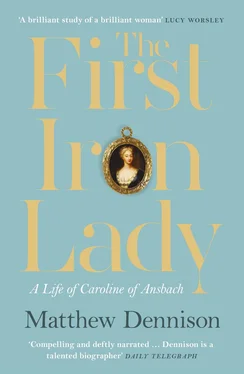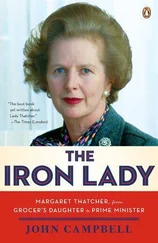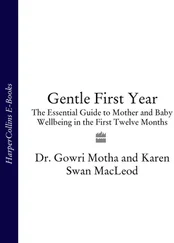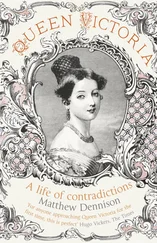Neither Frederick in Berlin nor Sophia in Hanover had been aware of the first parries of this lightning matchmaking. Predictably, their reactions were at odds. Confirmation of the forthcoming marriage was general knowledge by late July; Frederick’s ‘dissatisfaction’ and ‘ill humour’, directed at the court of Ansbach as well as that of Hanover, persisted throughout August and beyond. 18With arch disingenuousness and in words that mimicked his own, Sophia told Poley, ‘the Princess of Ansbach hath always been talked of at this court as the most agreeable Princess in Germany’. Less truthfully, given George Louis’s behind-the-scenes role as puppet-master and her own contribution in focusing attention on Caroline in the first place – as early as November 1704 she reported conversations with George Augustus, and ‘in talking with him about her [Caroline], he said, “I am very glad that you desire her for me”’ – she added that ‘the Elector had left the Prince entirely to his own choice’. 19In the long term such fine points of equivocation proved of no importance. It suited George Augustus’s preening nature to believe that ultimate credit for his ‘discovery’ was his own. At least Sophia did not dissemble her pleasure. Without sparing Frederick’s irritation, she told him, ‘I have never made a secret of loving the Princess from the moment I set eyes on her, or of desiring her for one of my grandsons.’ 20Letters from Liselotte at Versailles confirmed Caroline’s exemplary reputation and ignored Frederick’s wounded amour propre : ‘A great many people here have seen the Princess of Ansbach, and they are full of praise. I hope the marriage will be a happy one … It is very lucky when such a marriage gives everyone pleasure: it is not often the case.’ 21
Frederick’s fulminating was a risk George Louis was prepared to take. For Frederick, who had lived in close proximity to Caroline for almost a decade, the princess previously singled out by the emperor’s younger son and forged in Figuelotte’s image promised advantages to his newly royal dynasty as well as to Brandenburg-Prussia at large. In Hanover, however, the electoral family had more specific and more pressing reasons for courting Caroline.
In 1701, at an age when many of her contemporaries were dead, the dowager electress Sophia had experienced an upturn in her fortunes. With uncharacteristic but deliberate extravagance, she had welcomed to Hanover an English embassy led by the Earl of Macclesfield in mid-August that year. Its purpose was to present her with a copy of recent legislation passed by Parliament in Westminster and, on William III’s behalf, to invest George Louis with England’s highest order of chivalry, the Order of the Garter.
This was more than ordinary diplomatic flummery. In the Act of Settlement of June 1701, Hanover’s electoral family were named as heirs to the thrones of England and Scotland in the event of the death without issue of the current heir, Princess Anne, younger daughter of the deposed James II. First in line was Sophia herself. After her, in the Act’s key wording, came ‘the heirs of her body, being Protestants’: George Louis, then George Augustus.
This was not unexpected. William III had applied pressure to Parliament to pass a similar resolution as early as 1689. England’s Dutch king was well disposed towards Sophia. His friendship with the ‘good old duke’, her brother-in-law George William of Celle, was warm and of long standing, and he had been impressed by George Augustus after meeting him at George William’s court in October 1698. For all that, the Act’s implications were momentous. Hanover in 1701 was a region of limited international profile and territorially insignificant, mostly confined between the North Sea and the Harz Mountains and bounded by the Elbe and Weser rivers. It had been granted electorate status only within the last decade. Months earlier, it had been outflanked by the promotion of neighbouring Brandenburg, now effectively the Kingdom of Prussia, a piece of political leapfrogging decried by Sophia as ‘the fashion for Electors to become Kings’. 22In return for Protestantism, however, the Act of Settlement offered Hanover’s ruling family promotion to sovereigns of one of Europe’s oldest kingdoms, shortly to be formally ‘united’ by the 1707 Act of Union between England and Scotland. That the bride of George Augustus, now fourth in line to the British throne, should already have proven so convincingly her Protestant mettle ‘and in all her words and actions … declared herself to be on the most reasonable conviction, a sincere Christian, a zealous Protestant’ was an obvious recommendation in the aftermath of this seismic adjustment. 23
The significance of Caroline’s stand was increased by the nature of Sophia’s claim. Like England’s current heir Anne, Sophia was a granddaughter of James VI and I. She was the twelfth of the thirteen children of James’s eldest daughter Elizabeth, by her marriage Electress Palatinate and, briefly, Queen of Bohemia. Anne’s happy marriage to Prince George of Denmark had resulted in seventeen pregnancies but only a single child who survived infancy, William, Duke of Gloucester. He in turn died on 30 July 1700, aged just eleven, of acute bacterial infection exacerbated by pneumonia and water on the brain. 24
But his death did not make Sophia Anne’s closest heir. The second marriage of Anne’s father had produced a son, James Edward Stuart, who as a result of James’s religious conversion in the 1670s was a Catholic. In 1688, Catholicism had accounted for James’s own loss of his throne. Apparently in accordance with the will of the people, certainly in accordance with the will of sections of parliamentary opinion, James was replaced that year as England’s sovereign by his elder daughter from his first marriage, Mary, and Mary’s husband, the Dutch prince William of Orange, both of them Protestants, Mary devoutly so. Parliament’s Bill of Rights, passed the following year, sought to legitimise this dynastic shuffle, the so-called Glorious Revolution. The Bill formally excluded Catholics from the succession in perpetuity, and damned government by any ‘papist prince’ as ‘inconsistent with the safety and welfare of this protestant kingdom’. It was by this means that James Edward Stuart, brought up in exile on the generosity of Louis XIV of France, was stripped of his right to the throne. By the same means, more than fifty cousins and family members who were more closely related to Anne than Sophia, but who were Catholics or married to Catholics, including descendants of Sophia’s elder brothers and of Charles I’s daughter Henrietta, also forfeited their claims. Sophia’s ‘legitimacy’ as England’s heir stemmed from the rejection by Members of Parliament of the principle of hereditary succession. It was grounded in religious intolerance.
Her understanding of the contentious nature of her candidacy and its potential for divisiveness prompted Sophia’s commission of a commemorative medal, the ‘Mathilde medal’, ahead of Macclesfield’s embassy. Its two sides bore a profile of Sophia herself and, in a markedly similar portrait on the reverse, an English princess called Mathilde, the daughter of Henry II and Eleanor of Aquitaine. In 1156 Mathilde had married George Louis’s most warrior-like forebear, Henry the Lion, Duke of Saxony and Bavaria. More than Sophia’s Protestantism, the Mathilde medal celebrated former glories and the Hanoverians’ specifically ‘English’ descent. It was among Sophia’s gifts to the suite that accompanied Lord Macclesfield in the summer of 1701. The earl himself received a gold basin and ewer that had cost his hostess half her annual income, while to William III Sophia wrote tactfully, ‘we await [the] event without impatience here, and pray with all our hearts “God save the King”’. 25Periodically she took care to deny any personal desire to occupy England’s throne, a politic deceit on the part of this ambitious princess who, despite her age, was not above opportunism. Piously she wrote to Archbishop Tenison, ‘I live in quiet and contentment, and have no reason for desiring a change.’ 26
Читать дальше












